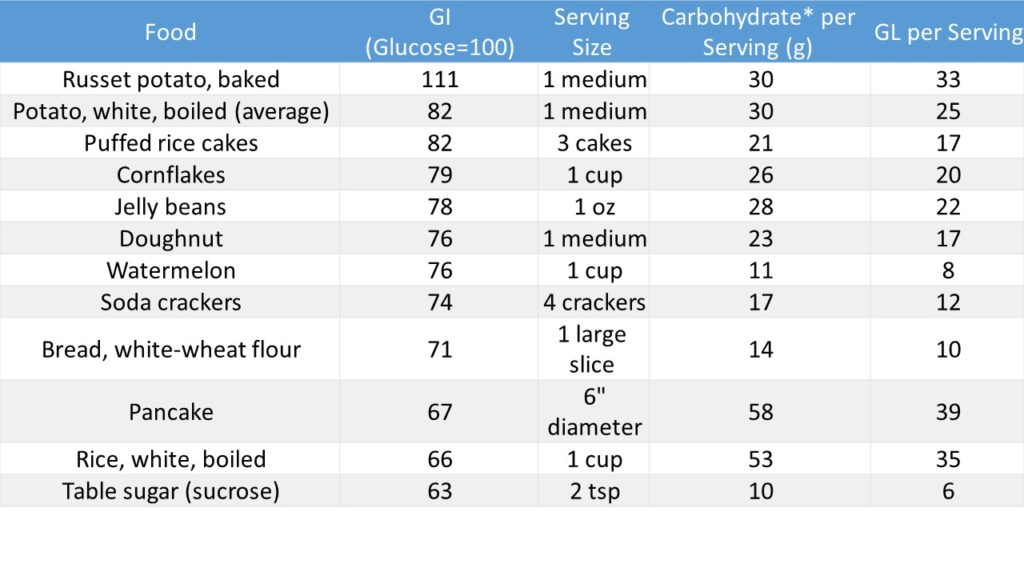Fruits are delicious and healthy and, generally recommended for all of us. But like any other food, we need to consume fruits wisely. Not only due to calorie values that might be high eventually, but also due to the rising sugar levels in the bloodstream.
Some fruits are also a better choice pre and post workouts and trainers that avoiding them not always do so for good reasons.
Not all fruits are equal, sugar wise as well, of course. So, also, the impact on blood sugar levels will differ. Choosing the right fruits to eat is extremely important for those who have diabetes.

The Glycemic Index (GI) is a tool to measure how individual foods are expected to impact blood sugar levels.
The GI number is a comparison between individual foods and sugar called glucose, with its given value of 100. Glucose is the form of sugar that runs in our bloodstreams to the cells.
The lower the GI index is, the less rise of sugar level is expected.
GI value monitoring can help for many people due to several reasons:
The Glycemic Load (GL) is an equation that takes into account the planned portion size of a food as well as the Glycemic Index of that food.
Glycemic Load = GI/100 multiplied by the net grams of planned carbohydrate (net carbohydrate is the total grams of carbohydrate minus the dietary fiber). In theory, a large amount of a low GI food may increase your blood sugar as much as a small amount of a high GI food.
Not only we need to keep an eye on the Glycemic Index of a food, it is important not to consume large amount of any food that can rise up the blood sugar in the same manner.
| Low | Medium | High | |
| Glycemic Index | 55 or less | 56-69 | 70 or higher |
| Glycemic Load | 10 or less | 11-19 | 20 or higher |
Some exaples for foods and their Glycemic values:


Diabetes is a chronic medical condition in which sugar, or glucose, levels build up in your bloodstream, uncontrolled. This happens when body cells aren’t able to respond to insulin as well as they should or body may not produce enough insulin.
Insulin is the hormone that helps to regulate the glucose level and it is released from the pancreas based on the rise or fall of the glucose level in the bloodstream.
For type 1 diabetes, the body is unable to process glucose, due to lack of it. The pancreas not producing enough, or at all, from it. For type 2 diabetes the body is no longer using the hormone efficiently, cells have stopped responding well to insulin.
There are several symptoms of Type 2 and type 1 diabetes. It may include:
Trainers usually try to avoid fruits, trying to avoid storing the Fructose (the fruit’s sugar) as fat when the liver is already full of Glycogen. Many times it is done not the right way and the trainers miss the benefits of fruits.
Those who suffer from type 2 diabetes can consume fruits as well, and there are plenty of fruits to choose from. Indeed not all fruits are good for diabetes because of the high levels of fructose but there are many fruits that slowly digested and the rise of the sugar in the bloodstream is more moderate.
This is mainly because fruits reach with fibers, which make the digestion process to take longer, so the release of the sugar and processing it to glucose take more time, so no rapid high peaks of sugar and no rapid lows.
So, what fruits are a good choice for such cases?
Lychees. with GL less than 8 can also be suitable for diabetes and provide vitamin C, antioxidants, potassium, magnesium, phosphorous, and fluids.
Figs. Figs have low carbohydrate contribution, vitamin A and fibers, but keep an eye on serving size. GI=51, GL=2 for 50 grams which is fine. But eating a few figs can bring it to GL of 16 or more. This is much higher than an apple, for example.
Bananas. Keep an eye on the serving size and you can enjoy this smoothie fruit. GI=53, GL=6.
What to be careful with especially? Watermelon, which has a GI of 76!. Pineapple also can be above GI of 65.
The problem with fructose, fruit’s sugar, arises when the liver glycogen levels are full. In such a condition, fructose is converted to stored fat. Therefore, many bodybuilders and general gym trainers try to avoid sugar of any kind and, that includes fruits. But being extremest is not necessary and it prevents you from consuming all the goodies of the fruits, vitamins, minerals, antioxidants, and fibers. Not to mention the good taste.
Therefore, we can choose the right times to consume fruits.
As for the watermelon, indeed less good for diabetes but it can be a good fruit consumption for the gym. the citrulline inside the melon contributes to muscles work as it gets converted to Arginine and Nitric-Oxide.
The last fruit to mention in this context is grapefruit. Grapefruit is a low-calorie fruit that is full with vitamins C and A. It has potassium, thiamine, and magnesium. Grapefruit helps to control appetite and may promote weight loss. It also contributes to the immune system and, may Help Prevent Insulin Resistance and Diabetes.
Leave a comment